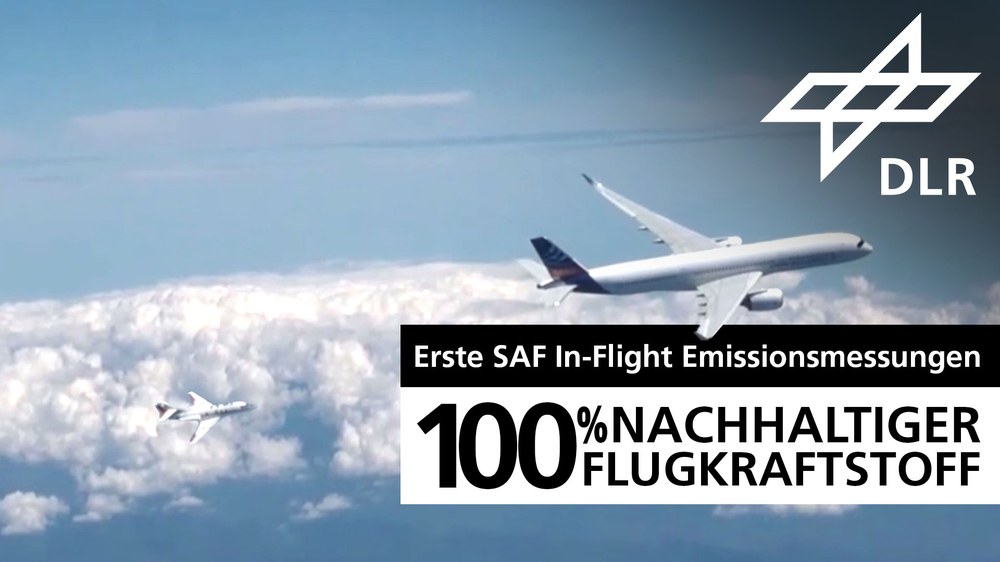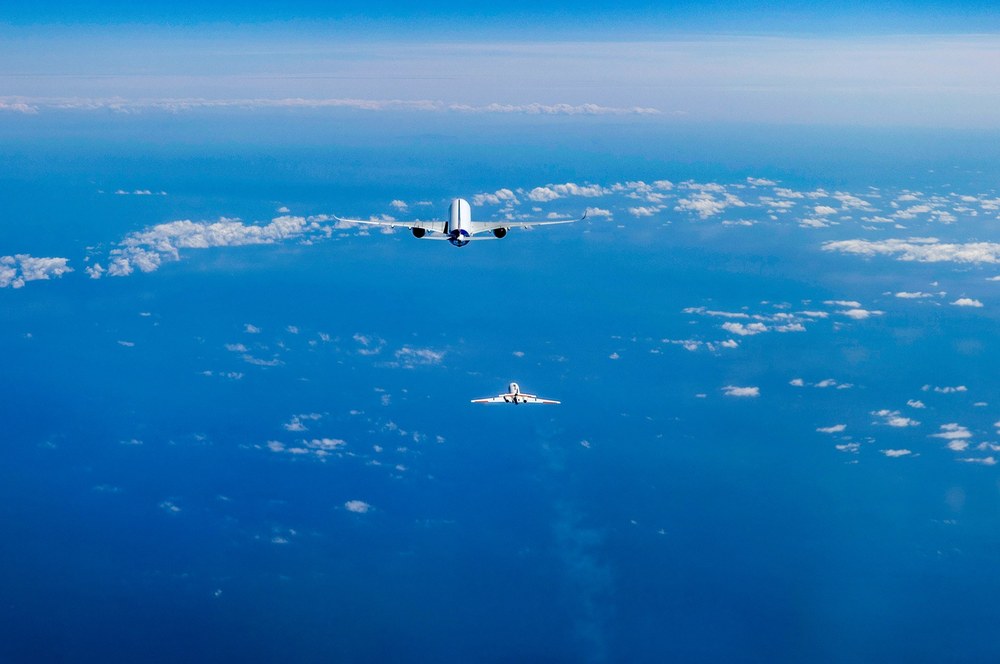First in-flight 100 percent sustainable-fuels emissions study of passenger jet shows early promise
- In November 2021, flight tests are again taking place with the DLR research aircraft Falcon 20E conducting emission measurements behind an Airbus A350.
- Initial results show that the engines release fewer particulates under all operating conditions when using pure sustainable fuels.
- Sustainable aviation fuels have the potential to reduce the climate impact of air transport.
- Focus: Aeronautics, climate-friendly flight, sustainable fuels
Toulouse, 29 November 2021 – Initial findings from a world-first study of the impact of 100 percent Sustainable Aviation Fuel (SAF) on both engines of a commercial jet have provided promising early results.
The ECLIF3 study, involving Airbus, Rolls-Royce, the German Aerospace Center (Deutsches Zentrum für Luft- und Raumfahrt; DLR) and SAF producer Neste, marks the first time 100 percent SAF has been measured simultaneously on both engines of a commercial passenger aircraft – an Airbus A350 powered by Rolls-Royce Trent XWB engines.
In-flight emissions tests and associated ground testing on the ECLIF3 programme began earlier this year and have recently resumed. The interdisciplinary team, which also includes researchers from the National Research Council of Canada and the University of Manchester, plans to publish its results in academic journals towards the end of next year and in 2023.
Findings from the study will support efforts currently underway at Airbus and Rolls-Royce to ensure the aviation sector is ready for the large-scale use of SAF as part of the wider initiative to decarbonise the industry. Aircraft are currently only allowed to operate on a 50 percent blend of SAF and conventional jet fuel, but both companies support the drive to certify 100 percent SAF use.
In April, the A350 flew three flights over the Mediterranean Sea pursued by a DLR Falcon chase plane to compare in-flight emissions of both kerosene and Neste’s Hydro-processed Esters and Fatty Acids (HEFA) sustainable fuel. The team also carried out compliance tests using 100 percent SAF and no operational issues were experienced.

Video – First in-flight emission measurements with 100 percent sustainable aviation fuel
Your consent to the storage of data ('cookies') is required for the playback of this video on Youtube.com. You can view and change your current data storage settings at any time under privacy.
In-flight emission tests using 100 percent SAF and a HEFA/Jet A-1 fuel blend resumed this month, while ground-based emissions testing to quantify the benefits of SAF on local air quality were also performed. The research team found SAF releases fewer particulates than conventional kerosene at all tested engine operating conditions, which points to the potential for reduced climate impact and improvement in air quality around airports.
In addition, SAF has lower density but higher energy content per kilogram of fuel compared to conventional kerosene, which brings some aircraft fuel-efficiency advantages due to lower fuel burn and less fuel mass on board to achieve the same mission. Detailed analysis by the team is on-going.
"Engines and fuel systems can be tested on the ground but the only way to gather the full set of emissions data necessary for this programme to be successful is to fly an aircraft in real conditions," said Steven Le Moing, New Energy Programme Manager at Airbus. "In-flight testing of the A350 offers the advantage of characterising direct and indirect engine emissions, including particulates from behind an aircraft at high altitude."
Simon Burr, Rolls-Royce Director of Product Development and Technology, Civil Aerospace, said: "This research adds to tests we have already carried out on our engines both on the ground and in the air which have found no engineering obstacle to our engines running on 100 percent SAF. If we are to truly decarbonise long-haul air travel, then 100 percent SAF is a critical element and we are committed to supporting its certification for service."
The DLR Falcon chase aircraft is equipped with multiple probes to measure emissions at cruise level down to a distance of only 100 metres from the A350 and feed them into scientific instrumentation for analysis.
"SAF has been shown to have a significantly lower carbon footprint over its life cycle compared to conventional jet fuel and now we are seeing it is advantageous in reducing non-carbon-dioxide effects too," said Markus Fischer, DLR's Divisional Board Member for Aeronautics. "Tests such as these are continuing to develop our understanding of 100 percent SAF and its use in flight, and we are seeing positive signs for its potential in climate mitigation. We look forward to studying the data from the second series of ECLIF3 flights, which restarted with a first chase flight above the Mediterranean earlier this month."
In 2015, DLR performed the ECLIF1 campaign, investigating alternative fuels with its Falcon and A320 ATRA research aircraft. These investigations continued in 2018 with the ECLIF2 campaign which saw the A320 ATRA flying with a mixture of standard jet fuel and up to 50 percent HEFA. This research showed the advantageous emission performance of fuel mixtures up to 50 percent SAF and paved the way for the 100 percent SAF test flights for ECLIF3.
Notes for editors: In-flight video footage of the DLR Falcon aircraft taking measurements from behind the 100% SAF-powered A350 aircraft is available to broadcast/online media.
DLR – research for climate-neutral air transport
The consequences of climate change demand action for climate-neutral air transport. This involves new technologies that will also ensure global mobility in the future. With its 25 institutes and facilities in the field of aeronautics research, DLR is driving this change forward with technologies for sustainable, environmentally compatible flight. Expertise from DLR's research programmes in space, energy and transport will also play an important role in this.
DLR has systems expertise in aeronautics research and sees itself in the role of an architect. DLR's goal is 'emission-free air transport', in order to achieve the climate targets that have been set. In doing so, the results of research must flow directly into the development of new products.
There is a considerable need for research and development on the path to climate-compatible air transport, which requires continuous funding and support. Much of this needs to be researched at a fundamental level, tested in practice and approved. DLR can do this with large-scale facilities such as its research aircraft, propulsion demonstrators and large-scale computers. In 2020, DLR published the white paper 'Zero Emission Aviation' together with the German Aerospace Industries Association (Bundesverband der Deutschen Luft- und Raumfahrtindustrie; BDLI). DLR is currently working on a Zero Emission strategy.
Climate impact of condensation trails
One third of the climate impact of air transport is due to carbon dioxide, while two thirds is caused by non-carbon-dioxide effects. Condensation trails and the resulting contrail cirrus clouds are the most significant factor. Aircraft engines emit soot particles, and these act as condensation nuclei for small, supercooled water droplets, which immediately freeze into ice crystals and become visible as contrails in the sky. The ice crystals in the condensation trails can persist for several hours in cold and humid conditions at altitudes of approximately eight to 12 kilometres and form high clouds, referred to as contrail cirrus. Depending on the position of the Sun and the characteristics of the underlying ground surface, these clouds can have a localised warming or cooling effect. Numerous research studies have shown that, globally, the warming effect predominates. The occurrence of these clouds is extremely variable in both time and space, and a relatively small number of contrails are responsible for a large part of the warming effect. For many years, DLR and its partners have been systematically investigating ways to reduce soot emissions and the climate impact of the resulting contrail formation. Together with NASA, DLR was able to demonstrate for the first time that the use of a 50-50 mixture of kerosene and Sustainable Aviation Fuel (SAF) halves the number of ice crystals in contrails under real flight conditions, which leads to a 20 to 30 percent reduction in the climate impact of the contrails.
Related News
- Aviation leaders launch first in-flight 100 percent sustainable-fuel emissions study on a commercial passenger jet
- DLR/NASA research flights over northern Germany
- NASA and DLR investigate the impact of aviation on the climate - joint flight tests on alternative fuel emissions
- A journey through an exhaust plume – DLR flight tests for alternative fuels



